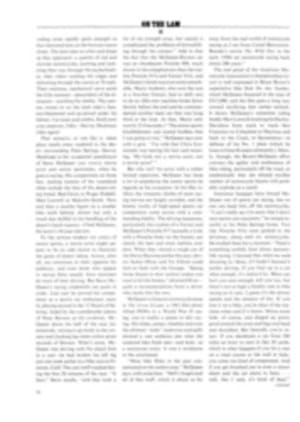
Formful win in a most formful affair
Girls' golf, observed a USGA man down in Augusta last week, is a very formful game. Despite the adolescent figures strolling the fairways at the U.S. Girls' Junior Championships in those trim, no-nonsense outfits, he did not mean it as a pun. One of the more durable pieces of male wisdom holds that women don't like surprises, and it seemed to go double for the teen-age girl golfers at Augusta. The unexpected need not apply.
All of them—the Debbys, Lindas, Cindys and Candys, the Aprils, LuAnns, Kimberlys and Mary Beths—came to the Augusta Country Club, next door to the Augusta National where the Masters is played, well supplied with hopes and hair ribbons. One hundred and one came, and after the qualifying rounds most of them went right back home again. The 32 left to fight it out in three days of match play were the 32 everyone expected to be there, including the one—Hollis Stacy—the rest wished had stayed away.
Form was followed with eerie precision down to the very last day, which is not to say that nobody tried. In this quiet, unturbulent pool of feminine order, a cool, braided, California blonde named Laura Baugh made quite a splash. She was an innocent troublemaker, but a troublemaker, nevertheless. First, in a field of 13- to 17-year-olds, of children emerging into adolescence and adolescents changing into women, she wasn't emerging at all. Miss Baugh had already emerged. She had one of the most confident walks ever seen, her perfectly tanned, well-formed legs swinging jauntily. The hair on her tapered arms was bleached absolutely white against a milk-chocolate tan. Her platinum hair was pulled smartly back into a Viking-maiden braid. Her tunic-skirted golf outfit contrasted with the essentially neutral uniform often adopted as protective coloration by girl golfers of that age. When Laura stooped down to line up a putt, she did it gracefully, as she seemed to do everything else. Never a moment of uncertainty, nor an awkward gesture. It was quite unfair.
The other girls never actually admitted they disliked Laura—whatever antipathy there was seemed to stem from the fact that she seldom conceded a putt, no matter how short. But that was merely part of her conservative game, which was manifested in other ways. She consistently chipped on the safe side of the ideal placement and consistently drove shorter than she was able. Actually, Laura Baugh is quite likable. Her father, Hale Baugh, came up from Florida to be with her in Augusta (Laura's parents are divorced), and his pride was evident. "Her mother has done a wonderful job with her," he said rather wistfully. He recalled how Laura at age four would tag along when her brothers played golf, hitting an occasional ball of her own. "We'd clap for her, then she'd play a hole or two. I made her a little club out of a wood block."
During the tournament she dallied with the idea of breaking out of her conservative mold at least once. "I wanted to wear tennis panties with my dress today," she said one morning. "I was just afraid the USGA wouldn't let me." And then, of course, she almost made golfing mischief. She nearly beat unbeatable Hollis Stacy.
Native to Georgia and a great local favorite, Hollis had won the last two junior championships, only the second player in 22 years to do so, and had done it walking away. Up to Thursday's match she had lost exactly two holes in two rounds. She had won her first-round match in 11 holes, and the talk among the caddies was that she could have won in 10, the minimum, but that would have been rubbing it in.
In her quarterfinal match with Laura Baugh there was no question of rubbing it in. Laura, who started off shakily with a bogey on the 1st, watched impassively as Hollis seemed up to her usual tricks. On the par-3 4th, Hollis hit her tee shot to within a foot of the pin, a hole in one that just stopped rolling. She went one up. Normalcy.
But somehow, Laura wouldn't follow the script. For the next 14 holes, she went two under par and did not bogey once. On every drive she was 20 yards shorter than Hollis, but her short game more than made up for it. On the 8th hole, a short par 5, she drew even. And on the ninth, she holed her pitch shot and went one up.
Now the imperturbable Hollis began to trudge. She swung around in frustration after missing a putt on the 14th and almost got three behind on the 15th before getting down in two from a trap. Hollis also put her second shot on 16 into a trap, next to a high green looking out over the national forest where all Augusta gathered in 1864 to watch for Sherman's March.
Once again the Yankees didn't make it. Hollis blasted out beautifully, Laura missed a long putt, then another, and Hollis was only one down. When Hollis won 18, it was even. Coolly, Hollis hit her best drive of the day on the 19th; Laura pulled into a sand trap, and Hollis had won.
Laura congratulated her opponent graciously and walked off the green under perfect control. But when her father told her what a good game she had played, she said fiercely, "I'm terrible! No one could be two up on the 16th and lose." There might have been a catch in her voice as she said it, but nobody could say for sure with Laura. So much for the unforeseen.
Meanwhile, another gallery pleaser, a 17-year-old strawberry blonde named Louise Bruce, was eliminated the same day—a loss for several reasons, among them for candid warmth and her slight Scottish burr. Louise's parents are archetypical Scots from the north (her grandmother was North-of-Scotland champion), giving her a special relationship with a course built by a Scotsman named Ross.
"I thought I recognized the Scottish sense of humor," she said wryly. "In fact, I'm sure I heard a dry chuckle when I went into one sand trap."
Fortunately, backers of dark-haired fillies were left with two splendid girl-next-door types on Friday. Donna Horton looked as you would expect a girl from Kinston, N.C. to look—like kin-folk. She had a pleasant, shy smile, a modest manner and soft voice and had begun golf only four years before, at age 13. The only reason she was here was that she had passed up the North Carolina Boys' JC Tournament, for which she had also qualified.
Mary Budke, another semifinalist, was a young lady of enthusiasm and friendliness, the devoted hope of all Dayton, Ore. (pop. 719), whose dad, a 28 handicapper, lamented his lot as the family's second-best golfer. "She doesn't give me any advice," he complained of Mary. "I've been trying to wriggle some out of her for years."
Of course dark horses do not win events as fraught with orthodoxy as girls' golf tournaments. Although she took Hollis Stacy to 17 holes, Donna Horton lost. And so, to Amy Alcott of Los Angeles, did Mary Budke—though she fought it through 21 holes.
In the finals Amy Alcott could scarcely be rated an underdog, even to Hollis Stacy. She had played golf since she was old enough to swing a stick, first learning the game by chipping from sprinkler head to sprinkler head on the Alcotts' Los Angeles front lawn. Only 15, she drives the ball 240 to 250 yards, farther than most women pros. She says she gets her strength from jogging, but one might also add that much of it comes from long years of participation in all kinds of sports.
"I used to think I was a boy," says Amy. "My knees and hands were always skinned. I would play the boys at football and baseball and beat them. They didn't like that. The girls hated me, too, because they had a crush on the sixth-grade teacher, and he liked me best because I liked baseball."
Against Hollis, Amy played one of the more remarkable rounds of golf ever seen in the junior championship. In the course of firing a three-under-par 70 over the 6,052-yard course, she birdied five holes and bogeyed only one. There was just one trouble. While all this was going on, Hollis Stacy was doing the same thing. As a result, Amy trailed most of the way, going one down to Hollis on the very first hole. The margin held through the first 17 holes, and nothing that happened to Amy on 18 seemed to augur an improvement. Her tee shot caught a fairway trap, and her second fell into a bunker near the 18th green. But then she blasted out to within three feet of the cup and sank her putt, which caromed from one edge of the hole to the other before dropping. Her birdie put her even with Hollis, and they were into the tournament's third sudden-death match in three days.
Hollis made quick work of it from here, however, sinking a 15-foot putt on the 19th hole of play and winning an unprecedented third-straight U.S. Girls Junior Championship. Her parents came up to Hollis afterward—her father almost sheepishly because it had been the first time he had come out to watch his daughter in competition (he usually stays home to babysit the Stacy brood) and he perhaps feared he had jinxed her, and her mother from behind a bush where she had hidden on both of Hollis' sudden-death holes, afraid to watch. "That was awful," said Jack Stacy, who poured himself a beer. Tillie Stacy gave her daughter an enormous hug.
Someone wondered what all the fuss was about. Nobody beats Hollis Stacy in match play. Not in a formful tournament like the Girls' Junior.
PHOTO
HOLLIS STACY (LEFT) ACCEPTS CONGRATULATIONS FROM RUNNER-UP AMY ALCOTT
PHOTO
BAUGH SIPPED AND PLAYED IT COOL

